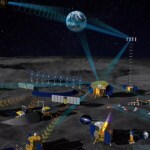Dominique Luchart's Blog, page 592
June 18, 2021
Tamagotchi’s new smartwatch lets you strap a needy digital pet to your wrist,

Everyone’s favorite digital pet, the Tamagotchi, is being reinvented for its 25th anniversary. The new Tamagotchi Smart puts the creature into a colorful smartwatch, allowing you to strap your digital pet — and all the chores that come with it — directly to your wrist. Kotaku reports that the new device features a touchscreen for petting your little friend, voice recognition for chatting, and a pedometer. Oh, and it can also display the time. Neat.
After their original release of the Tamagotchi in the late 90s, there was a global flurry of enthusiasm, leading to a spin-off anime series, video games, and a movie. The Tamagotchi Smart is fundamentally very similar to the 90s toys, but benefits from 25 years of tech progress. Its screen is color rather than monochrome, and there’s also wireless connectivity for interacting with other Tamagotchis. An official FAQ puts battery life at around 30 hours.
 Image: Bandai
Image: BandaiAccording to Gizmodo, Tamagotchi’s manufacturer Bandai is initially selling the Tamagotchi Smart via lottery, but the device will go on general sale on November 23rd for 7,480 yen (around $68). Buyers will be able to unlock extra content by plugging in small physical keys, which Bandai is selling separately for 1,100 yen (around $10). There’s no word of an official release outside of Japan just yet.
Personally, I swore I’d never love a Tamagotchi again after I was forced to watch my first digital pet die during a family road trip in the late ’90s. The ‘select’ button had fallen off the plastic egg into a public toilet (seriously), which left 8-year-old me unable to feed my little friend. Instead, I had to watch it die slowly as I helplessly cradled it in my arms. That day I swore I’d never open my heart to another digital creature.
Still though, the new smartwatch looks pretty neat, eh?
The post Tamagotchi’s new smartwatch lets you strap a needy digital pet to your wrist, appeared first on NEWDAWN Blog.
Taiwan’s government is letting its tech giants TSMC and Foxconn buy COVID-19 vaccines on its behalf,

Last year, Taiwan was held up as a model example of how to control the pandemic. Now, with a rising case-count threatening the country’s vital tech industry in the middle of a global semiconductor shortage, its government is letting its powerful corporations buy COVID-19 vaccines on its behalf. It’s an unusual workaround, but one that makes sense given Taiwan’s complaints that China scuppered earlier deals.
As reported by Nikkei Asia and Reuters, the Taiwanese government said on Friday that it would allow chipmaker TSMC and Terry Gou, billionaire founder of tech assembly giant Foxconn, to negotiate on its behalf with vaccine makers. Both TSMC and Gou (who will be working through his Yonglin Education Foundation) said they hope to buy around 5 million vaccines each from Germany’s BioNTech and donate them to the government.
Whether or not this approach will succeed is unclear. “The government thinks that it may be easier for companies to reach out to vaccine makers or distributors to lower the geopolitical interference,” one source told Nikkei Asia.
But Taiwan’s cabinet spokesman Lo Ping-cheng was more cautious, telling reporters: “Even if Mr. Gou can discuss this with the original manufacturer or an agent, can he get them to sell sufficient vaccines? Honestly, nobody knows.”
TSMC and Foxconn are lynchpins of both global tech supply chains and Taiwan’s economy. Together, the firms account for more 30 percent of island’s stock exchange by market capitalization, according to Nikkei. The global pandemic has created a worldwide shortage in chip supplies, leading to rising prices and missing stock for everything from PS5s to Teslas. Such problems could worsen if cases spike among Taiwan’s workers, forcing factory shutdowns.
Taiwan has a population of around 23 million, but only around six percent of the island’s inhabitants have received even a single dose of coronavirus vaccine, reports Reuters. The work of vaccinating the island has been complicated by geopolitical tensions. China considers the democratically-governed Taiwan to be a breakaway province that it wishes to exert full political control over. The US is one of the biggest obstacles to this integration.
Taiwan’s own government and sympathetic US senators say China has interfered with the island’s attempts to secure vaccines. In response, the US has promised to donate 750,000 shots to Taiwan “in very short order” while Japan has already exceeded this promise, donating 1.24 million doses of AstraZeneca’s vaccine earlier this month.
With cases of coronavirus rising, though, it seems Taiwan’s government is unwilling to simply wait on the largesse of its geopolitical allies. Instead, it’s hoping that its own corporations can assist in purchasing the much-needed shots.
The post Taiwan’s government is letting its tech giants TSMC and Foxconn buy COVID-19 vaccines on its behalf, appeared first on NEWDAWN Blog.
Spotify acquires podcast discovery specialists Podz, Jon Porter

 Illustration by Alex Castro / The Verge
Illustration by Alex Castro / The VergeSpotify has acquired Podz, a startup whose technology generates preview clips of podcasts, the streaming service has announced. Unlike other services podcasters can use to manually create clips, TechCrunch says Podz automates the process of finding key moments from episodes using machine learning trained on over 100,000 hours of audio.
The acquisition is aimed at improving podcast discovery, letting users browse short clips rather than 30-minute plus podcast episodes. Spotify says this will make it “easier for listeners to find the content they want to listen to, and for creators to be discovered and build a fan base.” Podz tells TechCrunch that users on its platform typically follow up to 30 podcasts, up from an average of seven.
M…The post Spotify acquires podcast discovery specialists Podz, Jon Porter appeared first on NEWDAWN Blog.
Spotify acquires podcast discovery specialists Podz,

Spotify has acquired Podz, a startup whose technology generates preview clips of podcasts, the streaming service has announced. Unlike other services podcasters can use to manually create clips, TechCrunch says Podz automates the process of finding key moments from episodes using machine learning trained on over 100,000 hours of audio.
The acquisition is aimed at improving podcast discovery, letting users browse short clips rather than 30-minute plus podcast episodes. Spotify says this will make it “easier for listeners to find the content they want to listen to, and for creators to be discovered and build a fan base.” Podz tells TechCrunch that users on its platform typically follow up to 30 podcasts, up from an average of seven.
The acquisition follows Spotify’s subscription podcasting announcement, in which it would allow select partners to charge for access to their content. Although Spotify isn’t planning on taking its 5 percent cut of subscription revenue until 2023, eventually it’ll have a direct financial incentive to encourage its listeners to find and subscribe to as many podcasts as possible. Especially since it’s now competing with Apple Podcasts’ own in-app subscriptions, which launched this week.
Spotify says it plans to integrate Podz’ technology into its platform, and that some of the results should be visible before the end of the year.
The post Spotify acquires podcast discovery specialists Podz, appeared first on NEWDAWN Blog.
June 17, 2021
New Oculus Quest update adds multitasking and wireless streaming for original headset,

Facebook is rolling out its v30 update to the Oculus Quest and Quest 2 VR headsets. As previewed earlier this week by Mark Zuckerberg, v30 includes a new multitasking interface for Infinite Office that lets you put multiple apps side by side, including the browser, Oculus TV, Oculus Move, the store, and so on.
Like many new Oculus Quest features, it’ll be found in the Experimental section of the settings menu at first. Once multitasking is enabled, apps can be dragged up from the menu bar or the apps library and snapped into position.
The v30 update also enables Air Link for the original Quest headset. Air Link came to the Quest 2 in April and allows you to stream VR games from your PC to your headset wirelessly, as opposed to Oculus Link which does the same thing over a USB-C cable. Original Quest owners could previously stream PC games wirelessly with the third-party app Virtual Desktop.
Other new features include the addition of an accessibility tab to the settings menu that, among other things, allows for height adjustment, so that games can be experienced from a standing viewpoint while seated. Oculus has also added the ability to switch the headset’s built-in microphone between system-wide party chat and the app you’re using.
As ever, the update might not hit your headset immediately due to the staggered rollout process, but Facebook says it’s coming.
The post New Oculus Quest update adds multitasking and wireless streaming for original headset, appeared first on NEWDAWN Blog.
Watch live today: SpaceX launching advanced GPS satellite for the US Space Force, ,

A SpaceX Falcon 9 rocket will launch a Global Positioning System (GPS) satellite for the U.S. Space Force on Thursday (June 17), and you can watch it live here.
The GPS III Space Vehicle 05 mission will lift off from Space Launch Complex 40 at Cape Canaveral Space Force Station in Florida during a 15-minute launch window that opens at 12:09 p.m. EDT (1609 GMT). After delivering the payload to orbit, the Falcon 9 rocket will return to Earth for a landing at sea.
You can watch all the action live in the window above, courtesy of SpaceX. The launch webcast will begin about 15 minutes before liftoff.
Related: SpaceX launches next-gen GPS satellite for US Space Force, lands rocket
SpaceX is targeting Thursday, June 17 for Falcon 9’s launch of the GPS III Space Vehicle 05 mission from Space Launch Complex 40 at Cape Canaveral Space Force Station in Florida. The 15-minute launch window opens at 12:09 p.m. EDT, 16:09 UTC, and a backup launch opportunity is available on Friday, June 18 with a 15-minute launch window opening at 12:05 p.m. EDT, 16:05 UTC.
Falcon 9’s first stage booster previously supported launch of GPS III Space Vehicle 04. Following stage separation, SpaceX will land Falcon 9’s first stage on the “Just Read the Instructions” droneship, which will be located in the Atlantic Ocean.
A live webcast of this mission will begin about 15 minutes prior to liftoff.
COUNTDOWNLAUNCH, LANDING, AND DEPLOYMENT
All Times Approximate
HR/MIN/SEC EVENT
00:38:00 SpaceX Launch Director verifies go for propellant load
00:35:00 RP-1 (rocket grade kerosene) loading underway
00:35:00 1st stage LOX (liquid oxygen) loading underway
00:16:00 2nd stage LOX loading underway
00:07:00 Falcon 9 begins engine chill prior to launch
00:01:00 Command flight computer to begin final prelaunch checks
00:01:00 Propellant tank pressurization to flight pressure begins
00:00:45 SpaceX Launch Director verifies go for launch
00:00:03 Engine controller commands engine ignition sequence to start
00:00:00 Falcon 9 liftoff
LAUNCH, LANDING, AND DEPLOYMENT
All Times Approximate
HR/MIN/SEC EVENT
00:01:12 Max Q (moment of peak mechanical stress on the rocket)
00:02:32 1st stage main engine cutoff (MECO)
00:02:35 1st and 2nd stages separate
00:02:43 2nd stage engine starts
00:03:27 Fairing deploy
00:06:18 1st stage entry burn begins
00:08:07 2nd stage engine cutoff (SECO)
00:08:33 1st stage landing
01:03:35 2nd stage engine restarts
01:04:19 2nd stage engine cutoff (SECO-2)
01:29:20 GPS III Space Vehicle 05 deploys
Find out what the astronauts and cosmonauts aboard the International Space Station are up to by tuning in to the “ISS Live” broadcast. Hear conversations between the crew and mission controllers on Earth and watch them work inside the U.S. segment of the orbiting laboratory. When the crew is off duty, you can enjoy live views of Earth from Space. You can watch and listen in the window below, courtesy of NASA.
“Live video from the International Space Station includes internal views when the crew is on-duty and Earth views at other times. The video is accompanied by audio of conversations between the crew and Mission Control. This video is only available when the space station is in contact with the ground. During ‘loss of signal’ periods, viewers will see a blue screen.
“Since the station orbits the Earth once every 90 minutes, it experiences a sunrise or a sunset about every 45 minutes. When the station is in darkness, external camera video may appear black, but can sometimes provide spectacular views of lightning or city lights below.”
Follow us on Twitter @Spacedotcom and on Facebook.
The post Watch live today: SpaceX launching advanced GPS satellite for the US Space Force, , appeared first on NEWDAWN Blog.
Canon put AI cameras in its Chinese offices that only let smiling workers inside,

Tech company Canon has come up with a downright dystopic way to tackle the problem of workplace morale: it’s installed cameras with AI-enabled “smile recognition” technology in the offices of its Chinese subsidiary Canon Information Technology. The cameras only let smiling workers enter rooms or book meetings, ensuring that every employee is definitely, 100 percent happy all the time.
This depressing tale was highlighted in a report from The Financial Times on how Chinese companies are surveilling employees to an unsettling degree with the help of AI and algorithms. Firms are monitoring which programs employees use on their computers to gauge their productivity; using CCTV cameras to measure how long they take on their lunch break; and even tracking their movements outside the office using mobile apps.
As the King’s College London academic Nick Srnicek told the FT: “Workers are not being replaced by algorithms and artificial intelligence. Instead, the management is being sort of augmented by these technologies […] Technologies are increasing the pace for people who work with machines instead of the other way around, just like what happened during the industrial revolution in the 18th century.”
Canon Information Technology actually announced its “smile recognition” cameras last year as part of a suite of workplace management tools, but the technology doesn’t seem to have gotten much attention. Indeed, the fact it passed under the radar is a good illustration of just how common surveillance tools like this are becoming — and not just in China.
Although readers in the West sometimes have a tendency to dismiss the sort of surveillance described by the FT as a foreign phenomena, countries like the US and UK are just as culpable. Amazon is perhaps the prime example of this dynamic: it’s known for squeezing every ounce of effort from its warehouse workers at the expense of their health, and even ranking their productivity using algorithms before firing those at the bottom of the scale.
Such modern-day Taylorism is not restricted to blue collar jobs, either: many modern software suites like Microsoft 365 come with built-in surveillance tools. And with more people working from home because of the pandemic, more companies are deploying these features for fear of losing control over their workers. (Or, for a slightly more cynical read: they’ve always wanted to use these tools and the pandemic provides a handy pretext.)
In other words: AI-enabled smile recognition cameras are in many ways the least dangerous types of surveillance technology. They have the benefit of being obvious. Other systems of control are much more subtle, and probably coming to an office near you sometime soon.
The post Canon put AI cameras in its Chinese offices that only let smiling workers inside, appeared first on NEWDAWN Blog.
On This Day in Space! June 17, 1985: First Arab and Muslim in Space, ,

On June 17, 1985, the space shuttle Discovery launched on NASA’s STS-51G mission, carrying payload specialist Sultan Salman Abdelize Al Saud, a Royal Saudi Air Force pilot who became the first Arab and first Muslim in space.
And because he was a prince in the House of Saud, he became the first member of a royal family to go to space. He was 28 years old at the time and holds the record for being the youngest person to fly on the space shuttle.
During the mission, he helped deploy a communications satellite called ARABSAT-1B for the Arab Satellite Communications Organization.
Catch up on our entire “On This Day In Space” series on YouTube with this playlist.
[image error]
History of NASA: $22.99 at Magazines Direct
Discover the story of how and why NASA was created, its greatest triumphs, darkest days, and of the times it exceeded all possible hopes. A tale of adventure, heroism and resourcefulness, learn of the space agency’s greatest achievements and how — over six decades — the organization has consistently and tirelessly devoted itself to its founding principle: that “activities in space should be devoted to peaceful purposes for the benefit of all humankind”. View Deal
Still not enough space? Don’t forget to check out our Space Image of the Day, and on the weekends our Best Space Photos and Top Space News Stories of the week.
Email Hanneke Weitering at hweitering@space.com or follow her @hannekescience. Follow us @Spacedotcom and on Facebook.
Join our Space Forums to keep talking space on the latest missions, night sky and more! And if you have a news tip, correction or comment, let us know at: community@space.com.
The post On This Day in Space! June 17, 1985: First Arab and Muslim in Space, , appeared first on NEWDAWN Blog.
Russia, China reveal moon base roadmap but no plans for astronaut trips yet, ,

China and Russia have invited international partners to join them in building a moon base but revealed they don’t plan to send astronauts to the moon in the next decade.
The International Lunar Research Station (ILRS) will consist of a space station in lunar orbit, a moon base on the surface and a set of mobile rovers and intelligent “hopping” robots, according to representatives of Russia’s space agency Roscosmos and China National Space Administration (CNSA).
Speaking at the Global Space Exploration Conference (GLEX) in St. Petersburg, Russia, on Wednesday (June 16), Chinese and Russian space officials said they were already in negotiations with international partners including the European Space Agency (ESA), Thailand, the United Arab Emirates and Saudi Arabia to join their endeavour.
Related: NASA unveils plan for Artemis ‘base camp’ on the moon beyond 2024
The two space powers signed an intergovernmental memorandum of understanding in March 2021 to go ahead with the project.
The timeline presented at the GLEX forum foresees a reconnaissance phase to begin in 2021. By 2025, the space agencies will choose a site for the moon base, with construction expected to follow between 2026 to 2035. The ILRS will become operational from 2036 onwards, providing a range of scientific facilities and equipment to study lunar topography, geomorphology, chemistry, geology and internal structure of the moon, as well as enabling space and Earth observations from the moon’s surface. It will also likely support human exploration in the future.
The base on the surface will be serviced via an orbiting station in cislunar space between the moon and Earth, that will see regular traffic between the two celestial bodies.
[image error]
The station will use autonomous technologies including hopping robots and rovers to explore the moon. (Image credit: Roscosmos/CSNA)CNSA vice administrator Yanhua Wu said at the conference that the partners are currently focusing on developing robotic lunar exploration technology and don’t plan to send astronauts to the moon within the next decade.
“We will also do a lot of preparatory work and research work in this aspect,” Yanhua said. “So we hope to be able to actually send our researchers to the surface of the moon in the future for them to carry out missions on the surface of the moon.”
Sergey Saviliev, deputy director general for international cooperation at Roscosmos said at the conference that while China and Russia have not yet been approached by any private companies, the nature of the ISLR project is meant to be inclusive and open to everyone interested.
Earlier this year, Russia announced plans to build its own space station in low Earth orbit, the region of space below 620 miles (1000 kilometers) and threatened to leave the International Space Station cooperation as a retaliation against U.S. sanctions.
China launched the first module of its new space station, Tianhe, into low Earth orbit in April this year. The station is set to receive its first astronaut crew later this week.
Follow Tereza Pultarova on Twitter @TerezaPultarova. Follow us on Twitter @Spacedotcom and on Facebook.
Join our Space Forums to keep talking space on the latest missions, night sky and more! And if you have a news tip, correction or comment, let us know at: community@space.com.
The post Russia, China reveal moon base roadmap but no plans for astronaut trips yet, , appeared first on NEWDAWN Blog.
Tantalizing Pluto views suggest active surface but won’t be seen again for 161 years, ,

For a brief moment in time in July 2018, the solar system aligned to show Earth the fully sunlit disk of Pluto, an arrangement that won’t occur again for 161 years.
Planetary scientist Bonnie Buratti was ready: She had been waiting for a decade for the opportunity to catch the rare sight in hopes of filling a gap in knowledge that even the carefully planned New Horizons mission couldn’t tackle. The result is an enigmatic plot of light from Pluto and its moon, Charon.
“We grasped this once-in-a-lifetime — well it’s once in more than a lifetime, once in two centuries — opportunity to see Pluto fully illuminated,” Buratti, who works at NASA’s Jet Propulsion Laboratory in California and is the lead author on a new paper presenting the observations, told Space.com.
Related: Beautiful, bewitching Pluto poses in images from New Horizons probe
Observations of a solar system body at and around the point of its maximum illumination allow scientists to measure what they call the “opposition surge,” a sudden increase in brightness of an object as it is fully illuminated, disproportionate to the extra sliver of surface area being illuminated.
And opposition surge isn’t just a curious optical phenomenon: Scientists believe the pattern of the surge is influenced by the density of material on a world’s surface. “By looking at how much an object brightens when it gets full, you can tell something about the surface texture and what the surface is like — is it fluffy? Is it snowy? Is it compact?” Buratti said.
For example, the opposition surge of the full moon is caused by the loose, dusty regolith at its surface, she said. “These particles cast shadows and those shadows rapidly disappear as the face becomes illuminated to the observer.”
A fully illuminated Pluto is difficult to catch from Earth because the inclination of the dwarf planet’s orbit compared to our own. Skywatchers use the term “opposition” to refer to the point in Earth’s year when a particular solar system object appears opposite to the sun in our skies. However, a celestial body doesn’t necessarily appear fully illuminated at that time, particularly something like Pluto that is often above or below the plane of Earth’s orbit around the sun.
Hence the 161 year wait for the next such opportunity and Buratti’s care to make a note of the 2018 opportunity so far in advance. She and her colleagues arranged for time using the 200-inch Hale telescope at the Palomar Observatory near San Diego. The Hale telescope is equipped with an optics system that could pick apart Pluto and Charon, rather than seeing one blob of the two worlds.
And the team managed to catch super-illuminated observations of Pluto on July 12, 2018, as well as other days that month and in July 2019. Buratti and her colleagues had more measurements planned for last summer, but the COVID-19 pandemic shut down the observatory.
The researchers still aren’t allowed to use the telescope in person, but finally, Buratti and her colleagues again have observations on the calendar, beginning on Saturday (June 19). She hopes those measurements, plus more next month and in October, will clarify just how Pluto’s opposition surge occurs, giving scientists the details they need to understand what might be happening on the ground to cause the visual effect.
Buratti said her suspicion is that the sharp opposition surge is related to how dynamic a world the New Horizons spacecraft discovered during its 2015 flyby. “Pluto is much more active than we thought,” she said. “We saw stuff we never saw before there.”
It’s the first solar system world beyond Earth known to sport glaciers, for example. Ices vaporize and refreeze, sometimes moving between Pluto and Charon in the process. “There might be snow on it [Pluto], there’s a lot of frost moving around, it might have a really fluffy, textured surface.”
Although the relatively close alignment of spacecraft flyby and full illumination from Earth is a pure coincidence, Buratti said the combination of observations is another example of how planetary science thrives best when using ground-based and space-based tools in tandem.
New Horizons saw night-side and halfway illuminated views of Pluto during its maneuver, she noted, but couldn’t see the fully illuminated disk because of the trajectory of its brief flyby. “You combine it with these ground-based observations and you have the full thing, you have the full package,” she said. “These are totally complementary.”
And for Buratti, the new observations are a poignant reminder of her own work during the New Horizons flyby, since it’s rare that scientists get to use equipment powerful enough to differentiate Pluto and Charon when observing the pair from Earth.
“We saw Pluto and Charon separately for the first time since the encounter,” Buratti said. “It’s kind of emotional for me … Here’s a thing that was just a point of light, and then in a day or two it becomes this geologic world and you feel like you’re there. It’s an intimate thing. But then it goes back to being a point again.”
The observations are described in a paper published June 8 in the journal Geophysical Research Letters.
Email Meghan Bartels at mbartels@space.com or follow her on Twitter @meghanbartels. Follow us on Twitter @Spacedotcom and on Facebook.
The post Tantalizing Pluto views suggest active surface but won’t be seen again for 161 years, , appeared first on NEWDAWN Blog.



